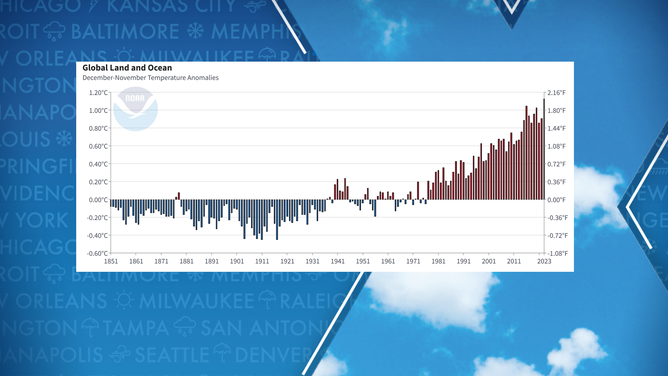Record-breaking global heat shows no signs of slowing in 2024
NOAA reported that November 2023 was one of several months that contributed to the world’s record heat. The average global land and ocean surface temperature for November 2023 was 2.59 degrees Fahrenheit above the long-term average.
Taylor Swift Eras tour faces storms, extreme heat
The 'Cruel Summer' singer has faced off with Mother Nature on her Eras tour over the past nine months. Taylor Swift danced in the rain with her fans in the U.S. and then faced extreme heat in Brazil.
As record-breaking heat impacted nearly the entire globe in 2023, scientists say 2024 will continue the trend with temperatures reaching new heights.
Britain’s national weather service, the Met Office, expects next year’s average global temperature to finish between 1.34 °C and 1.58 °C above average.
If the long-range outlook is accurate, it would beat 2023’s record, which currently sits at around 1.34 °C, with about a month of data to go.
Forecasters say this is not a surprise as the lagging effects of El Niño coincide with global climate change.
"The forecast is in-line with the ongoing global warming trend of 0.2 °C per decade, and is boosted by a significant El Niño event. Hence, we expect two new global temperature record-breaking years in succession, and, for the first time, we are forecasting a reasonable chance of a year temporarily exceeding 1.5 °C," Dr Nick Dunstone, a climate scientist at the Met Office, said in a statement.
If the year reached the critical threshold of 1.5 degrees Celsius, it would challenge benchmarks agreed to in the Paris Agreement signed during the United Nations Climate Change Conference in 2015.
EL NINO APPEARS TO BE ON THE VERGE OF RAPID COLLAPSE
Even though El Niño is set to disappear, impacts will continue to be felt
Any time global patterns are in flux, there is lag between what is experienced in the short-term and when conditions will reflect the new patterns that are in charge.
NOAA recently stated it expects El Niño to all but disappear in 2024, but the heat that is generated during the pattern could linger for a significant part of the year.
A lag is rather common as it takes longer for water to gain and lose warmth than it does for air.
Take the summer solstice, for example; even though it occurs every June in the Northern Hemisphere when the sun’s rays are most direct, oceans and land usually don’t peak in temperature until July or August.
"In addition to the El Niño event, we have anomalous high temperatures in the North Atlantic and Southern Ocean and together with climate change, these factors account for the new global temperature extremes," Adam Scaife, head of long-range predictions, stated.
El Nino is expected to weaken throughout 2024
Climate experts are now focused on when an El Nino could weaken, leading to climate changes around the globe.
November 2023 added to historic heat
NOAA reports the most recent November was the warmest the agency has ever recorded.
The average global land and ocean surface temperature was 1.44 degrees Celsius above the long-term average.
The month marked the sixth month in a row for records in 2023 and the 537th-consecutive month with temperatures above the long-term average.
Observations in Africa, Asia and South America helped propel the month into record territory.
Heat waves also led to global sea ice ranking as the second lowest during any November.
NOAA said Arctic sea ice covered about 3.73 million square miles while the Antarctic saw 5.51 million square miles.

Global land and sea temperature anomalies
(NOAA)

